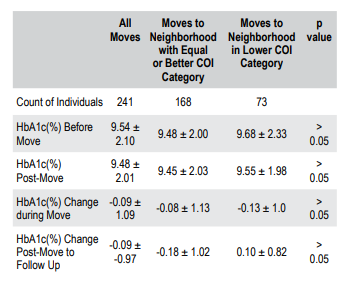Abstract: Impact of Moving to a New Neighborhood and Child Opportunity Index 2.0 (COI) on Near Term Hemoglobin A1c (A1c) in Youth with Type 1 Diabetes (T1D)
B. Lockee1, C. Vandervelden1, K. Panfil1, E. Tallon1, D. Williams2, S. Patton3, S. Mehta4, D. Tilden5, C. Schweisberger1, N.-H. Yayah Jones6, R. McDonough1, M. Clements1
1Children’s Mercy, Endocrinology, Kansas City, United States, 2Children’s Mercy, Kansas City, United States, 3Nemours Children’s Health, Jacksonville, United States, 4Joslin Diabetes Center, Boston, United States, 5University of Kansas Medical Center, Kansas City, United States, 6Cincinnati Children’s, Endocrinology, Cincinnati, United States
Introduction: Life stressors, such as changes in living situation, can negatively impact access to diabetes care and outcomes for youth with T1D.
Objectives: The Child Opportunity Index 2.0 (COI) measures neighborhood conditions related to child health. We investigated the impact of moving to a new neighborhood on glycemic control with additional attention to the impact of moving to a neighborhood defined by lower COI.
Methods: We analyzed electronic health records collected between 2016 and 2022 from a network of pediatric diabetes clinics in the Midwest USA. Patient addresses were geocoded using Degauss geocoding software. These data were combined with the publicly available COI data which assigns each census tract (containing ~4,000 people) to one of five neighborhood opportunity categories (very low, low, moderate, high, or very high) based on how it compares to other census tracts in the metro area. For a move to qualify for analysis, it must have been to a different census tract. We analyzed youths’ A1c results at three time points: (1) 30-150 days prior to the move, (2) within 30 days following the move, and (3) the first follow up visit, 60-180 days after the move.
Results: We identified 241 moves to a new census tract by youth with T1D (13.7 ± 4.0 years old, 58% non-Hispanic white, 28% commercial insurance, 45% female) and their families. Of these, 73 were moves to a neighborhood in a lower COI category. The mean(±SD) A1c change from pre-move to immediately post-move was –0.09% (±1.09). Mean HbA1c change from post-move to follow up was -0.0 9% (±0.97). Moving to a lower-COI neighborhood did not associate with a significant change in A1c in the immediate or near-term post-move periods

Conclusions: Although moving can disrupt the pattern of family life, we did not find an association with A1c increases in this study cohort. Future efforts should assess the impact of diabetes care team continuity and the reasons behind family moves to better understand this finding.
Link: https://www.react-profile.org/upload/KIT/system/uploads/ISPAD2023_Abstracts.pdf